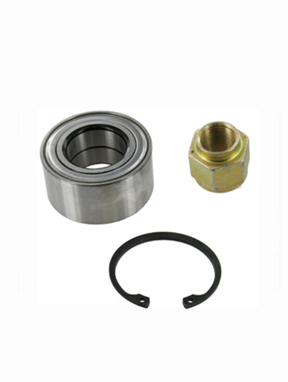

24hours on-line service, factory direct, 100% inspection,MOQ 100pcs. China Non-standard Bearings Suppliers
Add:Shangpu industry zone, Shangyu district, Shaoxing city, Zhejiang
Tel:+8613858544544
Fax:+86-0575-82007172
Mail:2850626308@qq.com
Mail:hengyuebearing@foxmail.com
1. When checking the tightness of the hub bearing, firs […]
1. When checking the tightness of the hub bearing, first put up the axle of the wheel at one end of the inspected hub of the car, and use the support bench, car cover and other tools to safely frame the car.
2. Turn the wheel under test several times by hand to see if the rotation is stable and there is abnormal noise. If the rotation is not stable and there is friction sound, it means that the braking part is abnormal; if there is no noise, the rotation is not stable and it is loose when tightened, which means that the bearing part is abnormal. The hub should be dismantled and inspected when the above abnormal phenomenon occurs. For small cars, when checking the wheel bearings, hold the tires with both hands on the upper and lower sides, and pull the tires back and forth with both hands, repeating it many times. If it is normal, there should be no feeling of looseness and blockage; if the swinging has a clear feeling of looseness, the hub should be dismantled.
3. Check the braking. Usually when checking the wheel bearings, the wheel brake device is also checked. If there is oil on the inside of the tire, it may be caused by the leakage of the brake cylinder or the brake oil pipe. The cause should be promptly identified and eliminated.
Maintenance of wheel hub bearings
Before disassembling the hub, you should make preparations for hub maintenance, stop the vehicle and build the axle to ensure the safety of maintenance operations.
1. After adjusting the hub bearing, drive for a period of time (about 10km) and stop to check the temperature of the hub. If it is hot, it is caused by the over-tightening of the bearing, and it should be re-adjusted to relax the tightness of the bearing.
2. Remove the tire nut and tire, taking care not to damage the thread of the tire bolt. If it is a disc brake, the brake should be removed and then used to remove the lock ring or pin.
3. Use special tools to remove the hub.
4. Scrape the old grease from the bearing, axle journal and hub cavity, clean the hub bearing and journal with a cleaning agent and dry them with a cloth, and finally clean the hub cavity with a cloth.

5. Check the hub bearing and bearing seat ring, and find that there are cracks, fatigue spalling and loose bearing rollers. The bearings should be replaced. If pitting is found on the bearing race, the bearing should also be replaced.
6. Check the fit between the inner diameter of the bearing and the journal. The fit clearance should not be greater than 0.1Omm. When measuring the journal, it should be measured at the upper and lower parts of the vertical ground (this is the largest wear part). If the fit clearance exceeds the prescribed service limit, the bearing should be replaced to restore the normal fit clearance. Burrs and pits on the journal are not allowed to reduce the gap.
7. After all parts meet the requirements, apply grease to the inner bearing and put it in the wheel hub.
8. When applying grease to the bearing cavity, the grease should be squeezed into the bearing until the grease comes out from the other side of the bearing. Apply a thin layer of grease to the hub cavity and the shaft head cover to prevent rust. Be careful not to apply too much grease in the hub cavity, otherwise it will affect heat dissipation and braking.
9. Put the hub and outer bearing back on the journal, screw the shaft head adjusting nut by hand, and then use the shaft head wrench to tighten the adjusting nut to the specified torque. After tightening the nut, turn the hub a few times to see if the bearing is installed; on the other hand, turn the bearing and seat ring to match properly. At this time, the bearing is properly tightened, and the wheel rotates freely without feeling the axial clearance.
10. Finally, install the lock piece, fixing nut, tire, dust cover and decorative cover in turn.